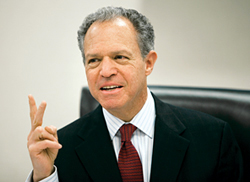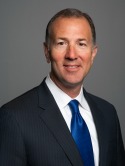Chicago Board Options Exchange chairman and chief executive officer Bill Brodsky and president and chief operating officer Ed Tilly broke bread with the New York City press corps in January in order to update the scribes on the exchange operator’s initiatives. Reporters learned that a quarter of CBOE’s volume came from proprietary products, specifically its index options, but over half its profits. CBOE’s year-old C2 exchange was achieving the company’s goals, the executives said, trading 228,000 contracts per day in last year’s fourth quarter, but they still increased its rebate in January. Traders Magazine presents a slice of the Q&A session.

Media: We hear you are planning to move the CBOE’s primary data center to New Jersey. Is that so?
Tilly: The location of the data center, whether it’s the back-up or the primary, is constantly under review. We are at a point where we need to make some longer lasting decisions about our current back-up facility, which is now located in one of the unnamed Chicago suburbs.
Media: What would be the advantage in moving CBOE’s primary data center and matching engines to New Jersey?
Tilly: Proximity to the underlying for the market makers who are using the underlying to price their 200,000 or so strikes. That proximity to NYSE and Nasdaq is extremely important. Not so much for the ability to get into the market but rather the feedback of ‘when am I out?’ The ability to know when you are off the market is equally important. So those are some of the advantages when we weigh our options as to where to locate the data center. It is certainly the proximity to the underlying.

Media: Could the Volcker Rule reduce liquidity on the CBOE?
Brodsky: No. Look at the major market making firms in options. I don’t think they are affected by the Volcker rule at all. These are proprietary firms that don’t hold customer funds. The Volcker Rule is focused on institutions that have deposits of customer funds. Look at the Top 10 options market making firms. Eight or nine of the ten are totally proprietary firms. They trade their own money. They don’t take customer funds.
Tilly: If anything, it would be an airpocket and not a game changer for the long term. The liquidity will show up.
Media: Which players are you targeting in the institutional arena?
Tilly: The insurance industry, for one. Consider a customized policy. You may open one today. It has S&P 500 exposure. The natural hedge to offset that exposure would be a contract that expires in 365 days from today. That’s the most pure vanilla. The other is long-term exposure to the S&P 500 for longer dated insurance. And that can be years-10 to15 years. For longer-dated options, on C2, we are able to list the SPXpm settlement, which is the convention. Electronically accessible contracts for a much longer duration for which we don’t necessarily need to rely on the traditional market maker on the floor of the CBOE.
So we have a number of solutions that are at the ready for the insurance sector. Also, for the last two years we have had a dedicated insurance industry track at our annual risk management conference. This year will be our third year that we are actively pursuing the insurance industry.
Media: Volume in volatility products is soaring. Who trades these Vix-related options? Retail? Hedge funds?
Tilly: Both. But the big, big uptick if you look at the Vix options chart is from the Barclays effect. I can’t stress that enough. Barclays [Bank] was the first mover in creating an exchange-traded note that tries to replicate the exposure of a futures contract. You have the VXX [iPath S&P 500 VIX Short Term Futures ETN]. You have the VXX options.
Media: So Barclays trades options?
Tilly: At the end of the day, Barclays needs to go in to CBOE options and futures to hedge their exposure.
Media: And others followed Barclays?
Tilly: Yes. It’s been a race to the marketplace. Each major institution wanted to have their own product. But at the end of day, they must be able to trade futures at the CBOE Futures Exchange or options at CBOE. They have to be able to hedge that exposure so they can deliver that to ETN noteholders, that same experience. So that was a big, big move.
Media: Besides the note issuers, hedge funds are the bigger traders?
Tilly: Yes.
Brodsky: Still, in the early days we didn’t expect any retail. We were shocked. The options customers are the most sophisticated individual customers of brokerage firms. We were surprised by the level of involvement by pure retail individuals.
Media: Did you work with the retail brokers?
Tilly: We spent a great deal of time educating the online brokers. The concept of parity [between the VIX and the futures] was an extremely difficult one to grasp. You have to look at the futures contract, not a spot VIX. It’s a big difference if you are a securities trader and you own the underlying and sell a call.



